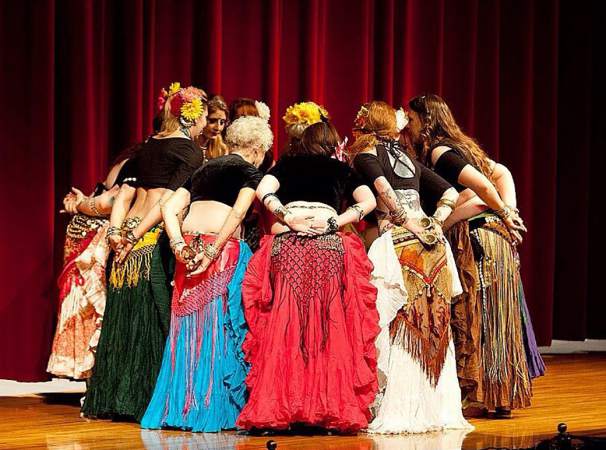The Pueblo Chieftain, Colo.
WWR Article Summary (tl;dr) Emily Boughton-Medina is the founder of the Pueblo-based “Desert Dearly dance company” which features belly dancing. Her artistic education began at a more typical location — the ballet barre. As a young girl, she studied ballet and tap. But after she learned about belly dance from her grandmother, Naoma “Oma” O’Neill, Boughton- Medina fell in love.
Pueblo, Colorado
It’s not hard to tell that Emily Boughton-Medina is a dancer.
The Wetmore native, who jokes, while holding her hands inches apart, that she has been dancing since she was “yay high,” grows animated when discussing the hobby that became her career. She is an expressive speaker, using her posture and gesticulations to illustrate a story or point.
All of which is helpful when performing the tale-weaving movements of belly dance.
“The hard things I’ve had to go through, the very awesome things I’ve gone through . . . I can make a dance that expresses (them),” Boughton-Medina said. “It brings a level of empathy. People are able to connect more.”
That’s part of the reason that Boughton-Medina, the founder of and creative director for the Pueblo-based Desert Dearly dance company will host a belly dance show Sunday.
The history of belly dance isn’t totally clear. By some estimates, it is the oldest form of dance (evidence indicates it has been practiced for six millennia) and certain research has tied it to pagan fertility rituals for women.
What we do know, Boughton-Medina said, is that it has roots in the Middle East, specifically in Egypt and Turkey.
Egyptian dance was handed down through the generations, Boughton- Medina said. Those groups consisted of both men and women who would perform in public for religious and entertainment purposes, according to the global education group World Belly Dance.
The Turkish style utilized intricate hip movements and torso articulations, shimmies and props like finger cymbals and veils.
Both styles were developed more for women’s entertainment than that of men, according to World Belly Dance.
As European travelers visited the region in the late 1700s and throughout the 19th century, they took dancers and the belly dance culture back with them.
Then came the 1893 Chicago World Fair and a dancer named Little Egypt. When fairgoers — properly dressed in the corseted garb of the era — saw her perform, many were scandalized. For those who subscribed to the propriety of the Victorian era, Little Egypt’s style and technique were seen as morally ambiguous. (Of course, the fact that the dance style was also influencing burlesques at this time didn’t help.) Hence, a folkloric dance technique became stigmatized as a form for improper, seductive or sensual women, according to World Belly Dance.
That has started to change, in the wake of the feminist movement of the late 20th century, the organization’s information showed. “You can see where our reputation has hit the gutter and it’s gone up again,” Boughton-Medina said. “Belly dancing is very empowering. . . . I’ve been trying to impart on my students that to say ‘belly dancer’ is OK.”
Family affair
Boughton-Medina’s artistic education began at a more typical location — the ballet barre. As a young girl, she studied ballet and tap.
But after she learned about belly dance from her grandmother, Naoma “Oma” O’Neill, Boughton- Medina fell in love.
O’Neill allowed her curious young granddaughter to watch videos of O’Neill belly dancing years earlier. And as Boughton-Medina’s interest grew, O’Neill taught her a few steps.
Today O’Neill is a member of her granddaughter’s company. “A lot of dance styles, you have to be a certain size or have your hair curled a certain way,” Boughton-Medina said.
buy temovate generic buy temovate online no prescription
Not so with belly dance, which she said “just pushes everybody else to better themselves.”
Unlike the more popular styles of dance — say, ballet, tap or jazz — anyone with enthusiasm and an interest to learn can belly dance, she said.
“You can maintain your size and your hair color and be yourself,” she said. “It’s opened the doors to an older community, as well. You don’t have to start very young, you can jump into it.”
Boughton-Medina teaches beginner, intermediate and history of belly classes on Thursdays at Open Studio Yoga, 120 Colorado Ave. She also teaches an eightweek series that includes choreography classes.
Sunday’s performance will include solos, company dances and smallgroup performances from five companies, she said. Audience members will have the opportunity to see everything from traditional, Middle Eastern choreography to contemporary tribal-fusion dances.
And if you happen to get inspired to take up the veil, that’s just fine with Boughton-Medina.
“I think that’s how people start troupes,” she said with a laugh. “I dance, I was moving to Pueblo and I wanted to teach people so we could dance together.”
rfoster@chieftain.com
___
(c)2016 The Pueblo Chieftain (Pueblo, Colo.)
Visit The Pueblo Chieftain (Pueblo, Colo.) at www.chieftain.com
Distributed by Tribune Content Agency, LLC.














































































































































































































































































































































































